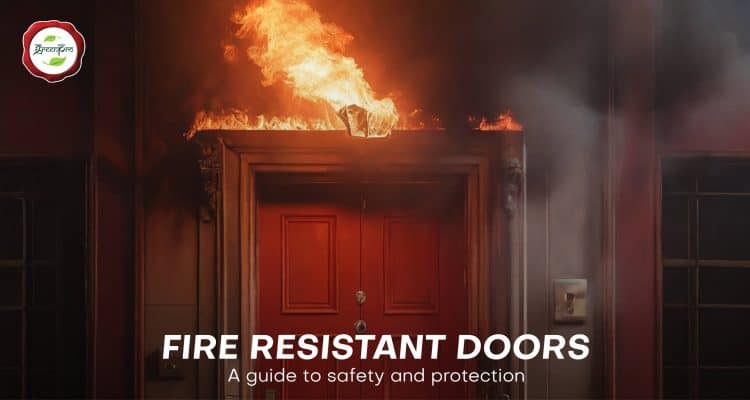Safety is a top priority in today’s world, especially when it comes to safeguarding people and property from the deadly consequences of fire. Fire resistant doors (FRD) are incredibly crucial safety measures, as they protect buildings and said beings when used as a barrier to the advancing flame and smoke. This all-inclusive guide will provide you with an in-depth piece on what fire resistant doors are, their construction, advantages, applications, and the regulations bound by these doors.
What are Fire Resistant Doors?
Fire-resistant doors are specially designed doors capable of withstanding fire for a given period of time. They are constructed from materials that at least have fire-resistant qualities or are simply treated with chemicals that give them fire-retardant abilities. An FRD is normally supplied with intumescent-type strips at the edges of the gaskets that rise in flame temperature and seal the periphery of the frame when exposed to heat.
FRD doors are typically made up of these materials
Core: A fire resisting material like wood, steel, or composite material would typically constitute the door’s core.
Facing: the outer layer of a door, used for decoration, and further protection of the core. The face can be made from materials such as wood, steel, glass, or combined.
Intumescent seals: These are located around the door frame. They expand anytime there is heat around them from surrounding seals, therefore sealing off any gaps that might allow entry of fire and smoke.
Smoke gaskets: These are gaskets that prevent the penetration of smoke through the door order.
Benefits of Fire Resistant Doors
Life Safety: FRD doors help improve safety in life as an exit way provided, in case a fire occurs. The doors can provide some reliable delays in the spread of the fire and smoke, giving occupants prolonged time to safely evacuate.
Property Protection: In cases of fire, FRDs offer protection for the building and the value inside it. It confines the fire in one region, thereby reducing how much damage is done in general to lower property loss.
Code Compliance: Many local jurisdictions require building owners to put up fire resistant doors to maintain occupant safety. FRD doors satisfy local building codes for building owners, making them exempt from legal actions, which may arise from failure to comply with such regulations
Insurance Benefits: The FRD doors lower insurance premiums. Insurance companies offer cheap insurance policies for building owners who have fire-resistant doors. They can quickly counteract the incidence of the roaring fire.
Peace of Mind: The supply of knowledge that your building is protected by fire-resistant doors will give you some serenity that your building and all it hosts, not forgetting its occupants, will be safe and secure from the various risks that are brought about by fire.
Applications of Fire Resistant Doors
Some of the applications of FRD doors are in various commercial buildings, offices, retail stores, hotels, and restaurants.Second, industrial facilities like factories, warehouses, and laboratories. Third, educational institutions, which include schools, colleges, and universities.
Healthcare institutions: Hospitals, clinics, and nursing homes
Residential buildings: Apartments, condominiums, and single-family homes
Fire Resistant Door Classifications
Fire doors rated according to minutes are done in the period of fire-withstanding time in a specified duration of time. This is the duration of hours taken so that before a door succumbs to the fire. For instance, a firer rated with a 1-hour rating will resist fire or 1 hour time, the exact rating needed by the will be dictated by the local building codes and the intent of the building. For an effective fire resistant door, they inevitably require maintenance and inspection, which comprises the following:
Visual inspections: This must be done from time to time to make sure the door has not experienced any damage, which could be cracks, dents, or even corrosion.
Operational testing: The test of the operation of the door is done from time to time and must show that once released, it actually closes and latches.
Intumescent seal inspection: Inspection to verify that the intumescent seals remain across the surface, are not cracked, and fully expand upon fire contact.
Smoke gasket inspection: Inspect the smoke gasket to see that it is whole and can function.
Conclusion
Fire-rated doors are an important part of building fire safety. Knowledge about advantages, applications, and maintenance of FRD doors assures the building owner the right decisions have been made in regards to property protection and safety of the occupant. Purchasing fire-rated doors would be a wise investment of peace of mind and perhaps even in saving lives.
